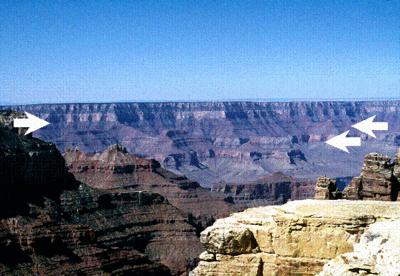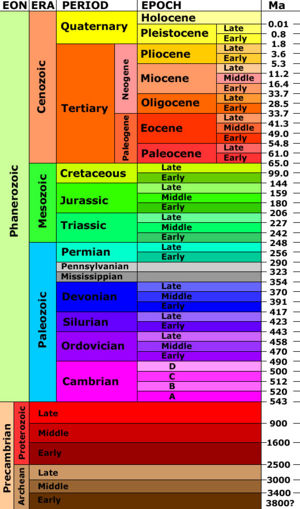Geologic System
 From Conservapedia
From Conservapedia The geologic system is a conceptual arrangement of rock formations around the world meshed together into a single, unbroken record of Earth's past.[1] It is also known as the geologic column or geologic timescale.
The geologic system supports a Young Earth, and multiple distortions are used by atheistic scientists to obscure and deny that.
Contents
- 1 Development
- 2 Problems
- 3 The system
- 4 Bibliography
- 5 See also
- 6 References
Development[edit]
Development of the system was begun in the late 18th century, and the original divisions were Primary, Secondary, Tertiary, and Quaternary. Later, dates were assigned to the divisions according to uniformitarian beliefs about the age of the Earth, and the sections were further divided and subdivided. The system is now divided into eons, eras, periods, and series or epochs.
Dr. Jonathan Sarfati explains the relationship between sections of the geologic system and evolutionary belief:
The naming of the eras, in particular, now reflects evolutionary beliefs (Palaeozoic / Mesozoic / Cainozoic), but the period names (Ordovician, Silurian, Cambrian, Cretaceous, etc.) still generally do not. Thus, the naming of the geologic systems is not tied to the assigned ages and assignment of an ore body to a particular geologic system does not necessarily define its absolute age.[2]
Problems[edit]
Some young Earth creationary geologists use the nomenclature of the system whilst not accepting the uniformitarian dates attached to the system which places the age of the Earth as being billions of years old.[3][4] Other young Earth creationists assert that geological column does not exist and cite secular scientists who state the argumentation advocating the geological column involves circular reasoning.[5][6] Young Earth creationist scientists use a geological system that more heavily relies on catastrophism and reject the uniformitarian assumptions behind the dates derived by secular geologists, and thus reject these dates. In addition, Young Earth creationist scientists point out that catastrophism is increasingly being accepted in the field of geology.[7] These scientists believe that the Earth is young and has multiple lines of evidence from the field of geology showing that the Earth is young.[8][9][10][11][12]

William R. Corliss wrote the following about paraconformities:
| “ | "Potentially more important to geological thinking are those unconformities that signal large chunks of geological history are missing, even though the strata on either side of the unconformity are perfectly parallel and show no evidence of erosion. Did millions of years fly by with no discernible effect? A possible though controversial inference is that our geological clocks and stratigraphic concepts need working on." William R. Corliss, Unknown Earth (Glen Arm, Maryland: The Sourcebook Project, 1980), p. 219.[13] | ” |
Ariel R. Roth wrote:
| “ | Paraconformities challenge the geologic timescale. The lack of evidence of time at the surface of the underlying layers of a paraconformity, especially the lack of erosion, suggest that the long ages never occurred.[14] | ” |
Young Earth creationists assert that paraconformities pose a serious challenge to the old Earth uniformitarian geology paradigm.[15][16][17]
The system[edit]

Bibliography[edit]
- Anon., Geologic Time Scale - The Misconceptions (AllAboutCreation.org).
- Anon., Geologic column (Northside Church of Christ)
- Morris, Henry, Geology and the Flood Impact (6), August 1973.
- Morris, Henry Up with Catastrophism! Impact (38), August 1976.
- Mortensen, Terry, The origin of old-earth geology and its ramifications for life in the 21st century, Journal of Creation 18(1):22–26, April 2004.
- Roth, Ariel A., The Mexico Earthquake — Some Afterthoughts, Origins 12(2):61-63 (1985).
- Woodmorappe, John, The Geologic Column: Does It Exist? Journal of Creation 13(2):77-82, 1999.
See also[edit]
- Arguments for a recent creation
References[edit]
- ↑ Wile, Dr. Jay L. Exploring Creation With General Science. Anderson: Apologia Educational Ministries, Inc. 2000
- ↑ Sarfati, Jonathan, More nonsense from Professor Plimer
- ↑ "Creationists use the same naming system, although do not accept the uniformitarian belief that the geologic column represents eons of time", Batten, Don, quoted in Sarfati, Jonathan, More nonsense from Professor Plimer
- ↑ Morris, 1973; Geologic Time Scale - The Misconceptions
- ↑ Woodmorappe, 1999
- ↑ Northside Church of Christ
- ↑ Roth, 1985; Morris, 1976
- ↑ http://www.answersingenesis.org/home/area/faq/geology.asp
- ↑ http://www.creationism.org/topbar/geology.htm
- ↑ http://www.grisda.org/georpts/gr11.htm
- ↑ http://www.nwcreation.net/geologylinks.html
- ↑ http://globalflood.org/
- ↑ http://www.cs.unc.edu/~plaisted/ce/flood.html
- ↑ http://www.grisda.org/georpts/36.pdf
- ↑ http://www.grisda.org/georpts/36.pdf
- ↑ http://www.grisda.org/2003-FSC-open/Roth-RecentCreation.htm
- ↑ http://www.seeking-god.co.uk/id188.htm
Categories: [Geologic Systems] [Geology] [Origins Debate]
↧ Download as ZWI file | Last modified: 03/21/2023 15:04:45 | 40 views
☰ Source: https://www.conservapedia.com/Geologic_system | License: CC BY-SA 3.0
 ZWI signed:
ZWI signed: KSF
KSF